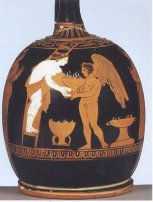Text
Laments for the departed Tammuz are contained in several Babylonian hymns, which compare him to plants that quickly fade. Thus the Mother Goddess likens him to a “tamarisk that in the garden has drunk no water” (Edena usagake l. 14), and “her lament is the lament for a herb that grows not in the bed, her lament is the lament for the corn that grows not in the ear” (ibid.). One of the rare attestations of Adonis gardens in the Levant is in Isaiah 17:10-11, which expresses a symbolism of death and sterility. The “gardens of Adonis” in Greek were a symbol of sterility and transitoriness, which was proverbial: “You are more sterile than the gardens of Adonis” (Zenobius, Cent. 1.49). The gardens of Adonis were in the form of symbolic plantations in vases or potsherds, but sometimes also in the form of real gardens. In 5th century BCE Athens, women sowed seed at midsummer in broken pots and placed these on the roof-tops, so that germination was rapidly followed by withering (Aristophanes, Lys. 708-739 with scholia). The real garden is mentioned in an inscriptions from Laodicea in Northern Syria as a 36m. long “garden of Adonis” with taverns. Similar plantations are known from Palmyra and Bethlehem, and the palace of Domitian contained a similar installation.
The daughter institution of the Adonis gardens are the small plantings in various vessels of seeds, mostly wheat, that we know from Christian celebrations in the Mediterranean. These descendants of the Adonis gardens are known from Sardinia, Sicily, Cyprus, Italy, Provance and Arabian Gulf culture. In Sardinia, they were called nenneri. At various places they are connected with different Christian celebrations: mainly Easter and the feast of St. John. The latter date is around Midsummer’s Eve, a date which recalls the celebrations of the Greek Adonia. The use of such plantings around Easter seems to suggest that there was a transfer of a major symbol of the Tammuz and Adonis celebrations to the central Christian celebration: the death and resurrection of Christ.
Sources (list of abbreviations) (source links will open in a new browser window)
Aristophanes, Lysistrata 708-739
Edena usagake 14
Isaiah 17:10-11
Zenobius, Cent. 1.49
Bibliography
| Cohen 1988, 683 | Cohen, Mark E. The Canonical Lamentations of Ancient Mesopotamia. 2 Vols. Potomac: CDL Press 1988. |
| Holes 2004 | Holes, Clive. “Arabian Gulf ḥiyya biyya, Jewish Babylonian farfisa, Christian Sicilian sepolcri. Popular Customs with a Common Origin?.” Journal of Semitic Studies 49 (2004) 275-287. [Oxford Journals (requires subscription)] |
| Mettinger 2001, 146-147 | Mettinger, T. Riddle of Resurrection. "Dying and Rising Gods" in the Ancient Near East. Coniectanea Biblica Old Testament Series 50. Stockholm: Almqvist & Wiksell International 2001. |
Links (external links will open in a new browser window)
Cf. Gardens of Adonis (2)
Amar Annus
URL for this entry: http://www.aakkl.helsinki.fi/melammu/database/gen_html/a0001413.php
|

